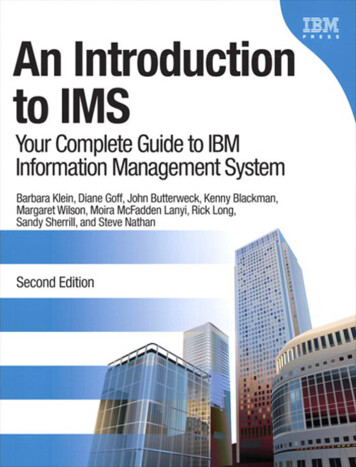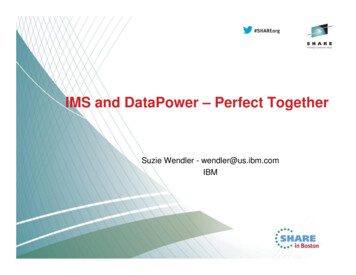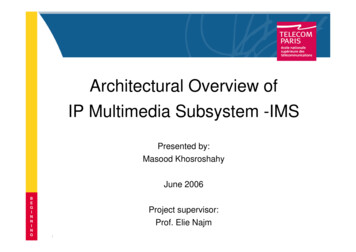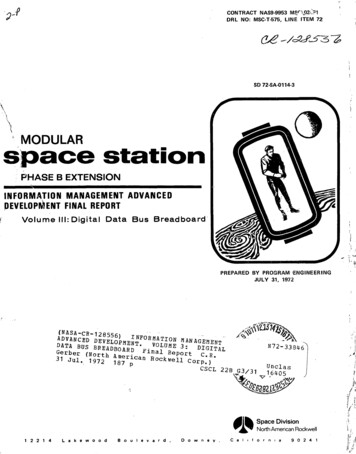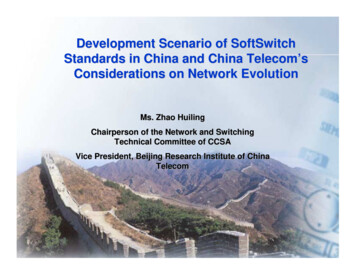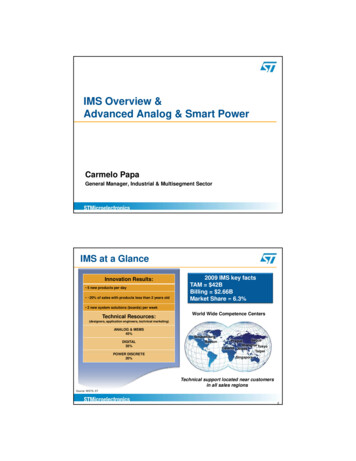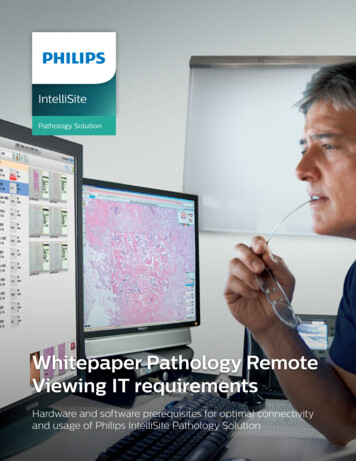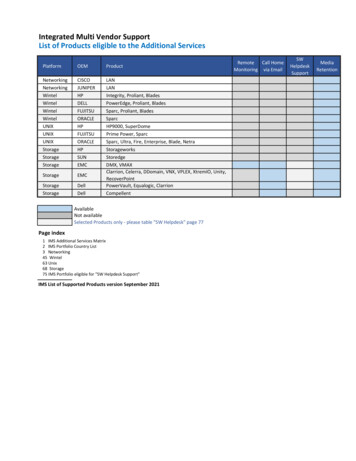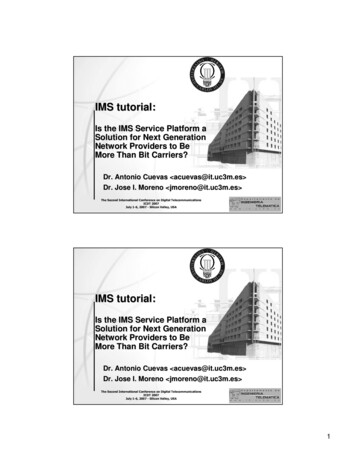
Transcription
IMS tutorial:Is the IMS Service Platform aSolution for Next GenerationNetwork Providers to BeMore Than Bit Carriers?Dr. Antonio Cuevas acuevas@it.uc3m.es Dr. Jose I. Moreno jmoreno@it.uc3m.es The Second International Conference on Digital TelecommunicationsICDT 2007July 1-6, 2007 - Silicon Valley, USAIMS tutorial:Is the IMS Service Platform aSolution for Next GenerationNetwork Providers to BeMore Than Bit Carriers?Dr. Antonio Cuevas acuevas@it.uc3m.es Dr. Jose I. Moreno jmoreno@it.uc3m.es The Second International Conference on Digital TelecommunicationsICDT 2007July 1-6, 2007 - Silicon Valley, USA1
Objectives This tutorial will: This tutorial will not: Present the IMS, a service platform key in NGNPresent IMS architecture CSCFs, PDF, MCF, AS, HSS,Present IMS interfaces and protocols, “internal” and externalPresent IMS philosophy, bias towards business modelsBias to NGN, and how IMS suits this and can be ported to thisEnter into details at “development level” e.g. we will say IMSsecurity is based on tokens but we will not say that thosetokens are hashes of 128 or 64 bits.Technical topics explained in a tutorial fashion. Alsobusiness related aspects and rationaleIMS tutorial2Index Introduction, Disruptions in Telco businessService platforms and business modelsSIP protocol and VoIP IMS Service Platform: SIP Proxies IMS Service Platform: key feature, enablingbusiness modelsIMS Service Platform: signalingIMS Service Platform: extra features & services IMS Service Platform: current deploymentsConclusion, IMS forecastIMS tutorial32
Striking Statements Lotsof Buzzwords and misconceptions incurrent telecommunication revolution Itis NOT about Fixed MobileConvergence. It is about IMS tutorial4It is about Telephony to Internetmigration (technologically) Circuit SwitchedPacket Switched (IP)IMS tutorial53
and convergence and coexistence(in business models)Distributed &Open(Internet)Monolithic &Closed(telephony)SemiWalledGardenIMS tutorial6Implications of a universal IP network Anydevice Any accesstechnologyIMS tutorial74
Implications of a universal IP network Anykind of use, fixed mobile, anyapplication This already works: don’t be dazzled bybuzzwords such as “convergence” (theyare mainly related to business aspects)IMS tutorial8Strong implication and disruptions Internetis not fully prepared for this!!!(TECHNOLOGICALLY) Strong research efforts toINTEGRATE (almost everything alreadyworks but in a stand alone manner) Businessplayers are neither prepared forthis Uncertainty, look for new business models,opportunitiesIMS tutorial95
From Telephony to Internet: Telcobreaks into piecesIMS tutorial10The future is to build linksBetween who is the key pointIMS tutorial116
The actors, fighting to gain a centralposition Networkproviders Migrating everything to a universal networkreduces Operational Expenditures They do not resign to become mere bit pipesand lose central position in the business valuechain.Money seems to be in the service deliveryDeustche Telekom president statement: makegoogle pay IMS tutorial12The actors, fighting to gain a centralposition service providersLike the Internet model as it isMake money beyond publicityStruggle to find new services/features that theusers are willing to payIMS tutorial137
The Scenario: 4G networks (or NGN) misconception of 4G: many think its just morebandwidthAlso a 4G network is much more than 3G’s “All-IP” in 3G, IP is an overlay,3G are networks with links to IP networks both fortransporting data and for control elements. But they areseparate networks.4G is a native IP network (thus much easier to integrateany access technology)So what’s a 4G Network (NGN)? No answer yet,but next slide may be a good approachIMS tutorial14A 4G networkApplications offeredby the networkoperator (e-mail,IPTv)Applications offeredby third party serviceproviders (e-mail,IPTv)Service Enablers.Service DeliveryPlatforms. May includeservices such as “Calls”(IMS)Operator’s core IP networkwith basic services: QoSenabled data transport,mobility, AAA InternetAccess Networkswith any kind ofaccess technologyand any kind ofdeviceApplications inthe InternetIMS tutorial158
Service platforms seem to be a meetingpoint, neutral zone Give really useful services: users willingness topay moreAll the players seem to take profit, share a fairportion of the telco. businessThus they are a key piece in 4G networksIMS is a promising service platformIMS uses SIP protocolIMS tutorial16Index Introduction, Disruptions in Telco business Service platforms and business modelsSIP protocol and VoIPIMS Service Platform: SIP Proxies IMS Service Platform: key feature, enablingbusiness modelsIMS Service Platform: signalingIMS Service Platform: extra features & servicesIMS Service Platform: current deploymentsConclusion, IMS forecastIMS tutorial179
Index Introduction, Disruptions in Telco business Serviceplatforms and businessmodels SIP protocol and VoIP IMS Service Platform: SIP Proxies IMS Service Platform: key feature, enabling business models IMS Service Platform: signaling IMS Service Platform: extra features & services IMS Service Platform: current deployments Conclusion, IMS forecastIMS tutorial18Internet Business model known toeverybody Networkoperator is a bit pipe. Open to allservicesTrust relationship3rdParty Service ProvidersTrustrelationshipTrust ty Service ProvidersTrustrelationshipIMS tutorial1910
The user receives many bills. E.g. Onefrom the e-travel agency forpurchasing via Web a ticket to Paris One from the Movie Theater for purchasingvia Web a ticket to see “E.T.” One from a content provider fordownloading a ring-tone Andone from the network operator: e.g.flat rate for ADSL, 10 /month or 1 /Gb forGPRS usage in the mobileIMS tutorial20The user may be “billed twice” EXAMPLE Theuser downloads a ring-tone: costs0,30 The ring tone is 100kb big The user employs a GPRS connection inhis mobile to access the Internet anddownload the ring-tone. He pays 1 /Gb The user pays 0,00001 for the traffic todownload the ring-toneIMS tutorial2111
The user needs to authenticate manytimes Mustprovide his billing data to all theentities (e.g. credit card number) Must login to all the entitiesIMS tutorial22In short Modelopen to many parties andservices The network operator is just a bit pipe Billing, authentication, is a nuisancefor the userIMS tutorial2312
Telephony Business model known toall of us Monolithicsolution, closed to servicesNetwork operator Service providerTrustrelationshipIMS tutorial24The user receives only one bill Thisbill is from the network provider Usually charged only for telephone calls orfor very limited services, like ring-tonedownloadIMS tutorial2513
The user needs to authenticate only tothe network provider Mustprovide his billing data only to thenetwork provider Must “login” (SIM Card in mobile networks)to the network providerIMS tutorial26In short Verylimited range of services. Modelclosed to other parties The network operator delivers thewhole serviceIMS tutorial2714
Semi-walled garden business model Networkoperator is a service broker.3rdParty Service Providers3rdParty Service ProvidersTrust relationshipNetworkoperatorTrustrelationshipIMS tutorial28The user receives only one bill Thisbill is from the network provider Vast panoply of services. The networkprovider will divert the money (retaining a%) to the service providersIMS tutorial2915
The user needs to authenticate only tothe network provider Mustprovide his billingdata only to the networkprovider Must login only to thenetwork provider The service providers donot see user’s data anddepend on networkprovider user managementIMS tutorial30In Short Innovativebusiness model Network provider is a bit pipe plus aservice broker It is open to all parties, its service panoplyis as rich as in the Internet It is as convenient as the telephony model,both for users and the network operator It is the CONVERGED business model Makespossible service aggregation andopens many opportunitiesIMS tutorial3116
The (operator-owned) service platform enablesthe semi-walled garden business modelIP NetworkIP NetworkServicePlatformIMS tutorial32Attention Userscan keep employing the “Internet”model Entice users to employ service platformsand the “semi-walled garden” model Price reduction Better servicesIMS tutorial3317
Service Platforms examples: i-mode Proprietaryof NTTDoCoMo, mainlyfor mobile phonesand serviceprovidersIP NetworkServicePlatformIMS tutorial34Service Platforms examples: i-mode Offersmany services under the semiwalled garden model Banking, e-shopping, news, games, restaurantguides, Hugesuccess and growing. By 2002: 31 Million subscribers3 000 services providers partnered with i-mode 50 000 web sites allied with i-mode IMS tutorial3518
Service Platforms examples: OSA OSA: Open ServiceAccess Not big successTarget services such ascontent downloadingNot proprietary;standardized by the 3GPP(like IMS) IP NetworkServicePlatformPart of the “Virtual HomeEnvironment”Offers a standard API(developed by Parlay) toservice providersIMS tutorial36Service Platforms examples: OSAServiceProvidersOSA API: Call control, UMTS QoS, User location,Terminal capabilities, Content based chargingOSA’s Service Capability ServersHLR/HSSLocationServer3G UMTS networkIMS tutorial3719
The IMS service platform Targets mainly user touser communications,like voice calls(traditional telephonyoperator service) Strongly based on SIPand on other openIETF protocolsStill, it is designed for3G UMTS networks IP NetworkServicePlatformIMS tutorial38Index Introduction, Disruptions in Telco business Service platforms and business models SIPprotocol and VoIP IMS Service Platform: SIP Proxies IMS Service Platform: key feature, enabling business models IMS Service Platform: signaling IMS Service Platform: extra features & services IMS Service Platform: current Conclusion, IMS forecastdeploymentsIMS tutorial3920
Internet, applications and protocols Abunch of protocols, most designed byIETF E-mail: pop3, SMTP, IMAP Web browsing: http VoIP, instant messaging: SIP H323 could also be used but, in principle, it ismore complicated and has not been adopted byIMSIMS tutorial40What is SIP? SIPis a signaling protocol to setup anykind of sessions When those sessions are voice calls, SIP isto the Internet what SS#7 is to mobiletelephony: a signaling protocol to setupvoice callsIMS tutorial4121
SIP: setting up the sessionINVITEFROM barbara@vodafone.comTO francisco@vodafone.comI have these audio codecs: MP3, GSM like, CDI have these video codecs: mpeg4, divX200 OKFROM barbara@vodafone.comTO francisco@vodafone.comI have these audio codecs: MP3, GSM likeI have these video codecs: divXIP omIMS tutorial42Media transmission. This is not SIPIP NetworkAudio and video packetsaudio codec: GSM likevideo codec: divXbarbara@vodafone.comfrancisco@vodafone.comIMS tutorial4322
SIP: tearing down the sessionBYEFROM barbara@vodafone.comTO francisco@vodafone.comIP Network200 OKFROM barbara@vodafone.comTO o@vodafone.comIMS tutorial44SIP Registrars Allthe above is nice and simple but In the Internet we can not route the packetsusing francisco@vodafone.com, we needthe IP address of the machine used byFrancisco Mapping IP addresses to users is thefunction of the SIP registrars User’s devices need to know the IPaddress of the SIP registrar (configuration,DHCP)IMS tutorial4523
SIP: RegisteringWell know ne.comIP address is 2.2.2.2REGISTERbarbara@vodafone.comIP address is 1.1.1.1200 OK200 OKIP MS tutorial46 and before sending the inviteWell know SIPregistrar(vodafone.com)Where isfrancisco@vodafone.comAt 2.2.2.2INVITEIP MS tutorial4724
Actually we use sip proxies SIPproxies can contact a registrar or are aregistrar They do not participate in the session butthey assist in setting it never traversedby the media packets They receive and forward the sip messages Their address must be know by the SIPterminals (configuration or DHCP)IMS tutorial48Using SIP ProxiesWell know SIPproxy(vodafone.com)Knows where francisco isand directs him thepacketsINVITEfrancisco@vodafone.com200 OKIP MS tutorial4925
Wrap-up INVITEand 200 OK let the conferees agreeon the session parameters SIP messages, not sent directly betweenthe conferees, they traverse a SIP proxy SIP Proxy/registrar maps user’s device IPaddress to user identification(francisco@vodafone.com) SIP proxy address must be know by theconferees Media transport is not SIP Media never traverses SIP proxiesIMS tutorial50SIP message format and messages SIPhas messages (e.g. INVITE), eachneeds 1 definitive answer. Exception: noanswer for the ACK message May also receive (0.n) provisional answers(codes 1XX) Definitive answers may be o.k. (codes 2XX)or k.o.IMS tutorial5126
Some useful provisional answers “180Session Progress” indicates all isgoing on “183 Ringing” tells the caller the calleephone is ringing. The “200 OK” defininetiveanswer will be received when the calleehangs-upIMS tutorial52A complete example http://www2.rad.com/networks/2003/sip/flash.swfIMS tutorial5327
Multiple domains and SIP proxiesWell know SIP proxy forbarbara (vodafone.usa).Looks for vofane.uk sipproxy: DNSWell know SIPproxy for nows wherefrancisco is anddirects him thepackets200 OKIP S tutorial54Multiple domains and sip proxies Eachuser must know his proxy He must register in his proxy/registrar.Only his proxy/registrar can map him andhis IP address Proxies know each other using DNS lookupIMS tutorial5528
Advanced SIP, more SIP messages Buddy listsUser SUBSCRIBE toproxies where buddies areregistered to, to receiveupdates about their stateUser PUBLISH the proxy ofhis status changesProxies NOTIFY the userabout the status changesthey have SUBSCRIBED to.IMS tutorial56IMS tutorial57User moves and changeshis IP addressMedia DataInvite withmy new IPaddressMedia Datadirected tonew IPaddressBye, to stopmedia data tothe old IPAddress29
User moves and changeshis IP address(a new SIP registration shouldalso be done)Media DataBye, to stopmedia data tothe old IPAddressInvitewith mynew IPaddressMedia Datadirected tonew IPaddressIMS tutorial58Advanced SIP: 1 user, several devicesWell know SIPregistrar & proxy(vodafone.com)200 OKREGISTERbarbara@vodafone.comIP address is 1.1.1.1200 OKREGISTERfrancisco@vodafone.comIP address is 3.3.3.3REGISTERfrancisco@vodafone.comIP address is 2.2.2.2IP Network200 OKbarbara@vodafone.comfrancisco@vodafone.comIMS tutorial5930
Advanced SIP: 1 user, several devicesWell know SIPregistrar & proxy(vodafone.com)INVITEINVITE tofrancisco@vodafone.com200 OK200 OKINVITEIP MS tutorial60Advanced SIP, more SIP messages Transferringa session from a terminal toanother I arrive to my office and transfer the video callfrom the PDA to the laptop.The user is previously “logged” in both devices(he did a REGISTER)REFER messageIMS tutorial6131
SIP REFER, Transferring a sessionfrancisco@vodafone.comVideo callREFERSend and INVITE to francisco to the laptop IP Address202 acceptedNOTIFY200 OKBYE200 OKFrancisco@vodafone.comVideo callbarbara@vodafone.comACK200 OKINVITEIMS tutorial62IP Address, IPv6, SIP and NATs Astelephones have numbers, each devicein the internet has 1 IP address (at least) Not enough IP addresses We use “private addresses” and NATs NAT works fairly well for client serverapplications but not for peer to peer anode with a private address can not becalled SIP is working on that Another solution is to employ IPv6 withmany more addresses availableIMS tutorial6332
DoesNOT use SIP, uses a proprietaryprotocol But it is the most popular VoIP application Solves many issues SIP is still trying tosolve like “NAT traversal” Rather than a “proxy/registrar” centricsolution, it employs a distributedarchitecture. Thus it scalable. Peer to peerSIP is a new research direction, imitatingthis ideaIMS tutorial64Index Introduction, Disruptions in Telco business Service platforms and business models SIP protocol and VoIP IMSService Platform: SIP Proxies IMS Service Platform: key feature, enabling business models IMS Service Platform: signaling IMS Service Platform: extra features & services IMS Service Platform: current deployments Conclusion, IMS forecastIMS tutorial6533
IMS seen as a service platform. A service platform that enables SIP calls betweenusers. Those calls are billed in the mobile network!AAA is done by the network operator semiwalled garden business model IMS is also owned by the network operator but,conceptually, this holds.SIP proxies form the core IMS, but it has manymore nodes and interfaces towards the networkoperatorSome call it “Network” But I reserve the term of network to atelecommunications network routing data packets froman origin to a destination: The Internet is a network ofroutersIMS tutorial66IMS as a merge of two worlds IMSis a SIP platform running andinteracting with a UMTS mobile network.Thus merge of two worlds, IETF and 3GPP 3GPP: IMS was introduced in UMTS release 5 (june2002)Keeps evolving: Release 7 IETF More than 40 RFCs dedicated to IMS, e.g.tailoring IETF protocols to IMSIMS tutorial6734
Other IMS actors 3GPP2for IMS in 3G CDMA2000networks Very similar to 3GPP IMS for 3GUMTS networks ETSITISPAN initiated the IMS,now devoted to porting it toNGN and other networks suchas ADSL OMA: to define services overIMSIMS tutorial68IMS tutorial69IMS step by stepDesigned for 3G UMTS networks3G UMTS network with SGSN,etc.35
IMS step by stepBut IMS works over IP (v6)IP Network (like the Internet)GGSNGateway from theUMTS network toother networksGGSN3G UMTS networkVoice, VideoIMS tutorial70IMS step by stepIMS is a infrastructure of SIP proxies CSCF (SIP Proxy)IP Network (like the Internet)SIP signalingGGSN3G UMTS network.Voice, VideoIMS tutorial7136
IMS step by step that can interact with some UMTS nodesCSCF (SIP Proxy)SIP signalingGGSN3G UMTS network. None of the“transport nodes” are exposedVoice, VideoIMS tutorial72IMS step by stepMedia does not reach the IMSCSCF (SIP Proxy)SIP signalingGGSN3G UMTS network. None of the“transport nodes” are exposedVoice, VideoIMS tutorial7337
IMS step by stepMedia may also reach the Internet, but never traversesthe IMS nodes (SIP proxies)CSCF (SIP Proxy)SIP signalingGGSN3G UMTS networkVoice, VideoIMS tutorial74In IMS, different types of SIP proxiesP-CSCF IMS contact point for the user’s SIP signalingSeveral in a domainLocated in the visited domainTerminals must know this proxy (e.g. DHCP used)Compresses and decompresses SIP messagesSecures SIP messagesAssures correctness of SIP messagesIMS tutorial7538
In IMS, different types of SIP proxiesS-CSCF Controlsthe user’s SIP Session 1 or a few in a domain Located in the home domain Is a SIP registrar (and proxy)IMS tutorial76In IMS, different types of SIP proxiesI-CSCF domain’scontact point for inter-domainSIP signaling 1 or a few in the domain In case there are more than 1 S-CSCFs inthe domain, locates which S-CSCF isserving a userIMS tutorial7739
IMS SIP signaling pathsimplest case: 1 domain, no roamingP-CSCF(SIP Proxy)S-CSCF(SIP Proxy)P-CSCF(SIP Proxy)SIP signalingGGSN3G UMTS network. None of the“transport nodes” are exposedVoice, VideoUser 1User 2IMS tutorial78IMS tutorial79IMS SIP signaling pathhardest case: 4 domains, roamingUMTS network is only used in the visited domains Media goes directly S-CSCFS-CSCFP-CSCFP-CSCF40
Index Introduction, Disruptions in Telco business Service platforms and business models SIP protocol and VoIP IMS Service Platform: SIP Proxies IMSService Platform: key feature, enablingbusiness models IMS Service Platform: signaling IMS Service Platform: extra features & services IMS Service Platform: current deployments Conclusion, IMS forecastIMS tutorial80UMTS networks are QoS enabled There are four QoS Classes in UMTSConversational, Streaming, Interactive,Background. QoSclasses are mapped to BearerServices The user, to employ the bearer services,needs to activate a PDP context PDP context are mapped to flows traceable QoS Butout of reach of IMSIMS tutorial8141
How the IMS can enjoy UMTS’ QoS? As we know, IMS SCSFs (SIP Proxies) caninfluence the signaling and are aware of the QoScharacteristics of the session to be setup Those characteristics include the codecs used and theirrequired B.W. and other requirements for the transportnetwork But SIP Proxies can not influence the data/mediaflows, neither the network transporting them Need of an intermediary: The PDFIMS tutorial82QoS in IMS: a scenarioTwo users want to setup a video call. The video flow needs128 kbps, the audio one 16 kbpsCSCF (SIP Proxy)SIP signalingContains mediaflows requirementsfor the network(codecs, BW)GGSN3G UMTS network transporting themedia flows.IMS tutorial8342
QoS in IMS: a scenarioThe PDF instructs the network to accommodate these flowsCSCF (SIP Proxy)PDF. Instructsthe network toaccommodatethe media flowsSIP signalingContains mediaflows requirementsfor the network(codecs, BW)GGSN3G UMTS network transporting themedia flows.IMS tutorial84QoS in IMS: a scenarioMedia flows traverse the networkCSCF (SIP Proxy)PDF. Instructsthe network toaccommodatethe media flowsSIP signalingContains mediaflows requirementsfor the network(codecs, BW)GGSN3G UMTS network transporting themedia flows.Media FlowsIMS tutorial8543
The central role of the PDF The PDF is, for the service quality (QoS), like anintermediary between the QoS defined at theapplication level (IMS) and its actual enforcementat the network level (in 3G networks in the GGSNnodes). QoS is to be given in the access (visited) UMTSnetwork, namely the GGSN PDF is located in the visited network.P-CSCFs are the CSCFs (SIP proxies) firstcontacting the user and located in the visitednetwork Thus we have PDF to P-CSCF interactionIMS tutorial86Details about PDP context APDP context is “pre setup” for the SIPsignaling. The exact procedure for activating PDPcontexts for the media flows is describednext When the session ends, those PDPcontexts are deactivatedIMS tutorial8744
QoS in IMSPDP context activation detailsCSCF (SIP Proxy)RequirementsPDFSIP signalingDecision &ConfigurationGGSNActivate PDPcontext3G UMTS networkActivate PDPcontextIMS tutorial88AAA in IMSemulating the semi-walled garden business model InIMS we enjoy single sign on and unifiednon duplicated billing, all centralized by theUMTS network control elements Let’sdeal now with accounting, chargingand billing IMS can not bill its users. It will just sendaccounting information to the networkoperator’s UMTS nodes. Centralizing pointwill be the network operator, its UMTSinfrastructure.IMS tutorial8945
Charging in IMSa use case Peopleare used to pay for voice calls (notin the Internet!!) Voice calls are typical IMS sessions But we saw that IMS also influences thetransport network resources Those resources need also to beaccounted and influence the charging.They may not be billed Like in the previous scenario, a link mustbe done between the accounting andcharging done at network and “IMS” levelsIMS tutorial90Charging in IMS: a scenarioTwo users want to setup a video call. One is 18 years old,the other not. Time is 9 pm.CSCF (SIP Proxy)CSCF is aware of thesedetails (video call duration,participants, start time .)SIP signalingGGSNUser 13G UMTS network transporting themedia flows.Media FlowsUser 2IMS tutorial9146
Charging in IMS: a scenariovideo audio flows consume network resourcesCSCF (SIP Proxy)GGSN is aware ofthese details (bytessent/ received )GGSNUser 13G UMTS network transporting themedia flows.Media FlowsUser 2IMS tutorial92Charging in IMS: a scenarioUMTS’ CDF/CGF gathers and correlates both dataCSCF (SIP Proxy)CDF/CGFGGSNUser 13G UMTS network transporting themedia flows.Media FlowsUser 2IMS tutorial9347
Where (in which domain) to performaccounting? Network resources are always consumed in thevisited domain (may not consume networkresources in home domain)Charging and billing to the user is done by theuser’s home domain. Accounting data must besent thereVisited operator may bill home operator forconsuming network resourcesSo, something is accounted in both visited andhome domains, both for caller and calleeIMS tutorial94Apart from gathering different data fromdifferent sources, we need to correlate it accounting: is able to correlate the accounting attwo levels: Network usage (e.g. bytes sent/received) Application characteristics E.g. in a voice call, number of parties involved andduration E.g. in streaming a movie, if it was done in prime timeand type of movie (recent hits)This allows, according to the business modelused, unified billing and non duplicated billing.IMS tutorial9548
Apart from gathering different data fromdifferent sources, we need to correlate it:Charging identifiersCallertransportsession 1Calleetransportsession 1Global and commonIMS sessionCallertransportsession 2Calleetransportsession 2IMS tutorial96Charging, roaming scenariodomains and e’shomeS-CSCFP-CSCFIP network (the internet)PDFPDFCDF/Caller’s CGFvisited 3GnetworkCDF/CGFCallee’svisited 3GnetworkIMS tutorial9749
Charging, roaming scenariocharging identifiers, creation and �shomeICIDS-CSCFP-CSCFICIDICIDICIDIP network (the internet)PDFPDFICIDICIDCaller’svisited 3GnetworkCallee’svisited 3GnetworkIMS tutorial98Charging, roaming scenariocharging identifiers, creation and ID1Callee’shomeICIDS-CSCFGCID2IP network (the internet)PDFGCID1Caller’svisited 3GnetworkP-CSCFICID/GCID2PDFGCID2Callee’svisited 3GnetworkIMS tutorial9950
Charging, roaming scenarioaccounting/charging depends on 3G infrastructureCDF/CGFP-CSCFCDF/Callee’s 1P-CSCFICID/GCID2IP network (the internet)ICID/GCID2ICID/GCID1CDF/Caller’s CGFvisited 3GnetworkCDF/CGFCallee’svisited 3GnetworkIMS tutorial100Charging, roaming scenariocharging info exchange (pure UMTS procedure)CDF/CGFCaller’shomeCDF/Callee’s CGFhomeP-CSCFIP network (the internet)CDF/Caller’s CGFvisited 3GnetworkCDF/CGFCallee’svisited 3GnetworkIMS tutorial10151
Charging, roaming scenariocharging system detailsCDF/CGFP-CSCFCDF/Callee’s 1P-CSCFICID/GCID2IP network (the internet)ICID/GCID2ICID/GCID1CDF/CDF/CGFCaller’s CGFvisited 3GnetworkCallee’svisited 3GnetworkIMS tutorial102Charging/billingsystem detailsS-CSCFCDF/CGF detailsP-CSCFCDFCGFBSTo otheroperators’billingsystemsGGSN3G UMTS networkIMS tutorial10352
Authorization and Authentication. Singlesign on Ifwe account resources we need toauthenticate the billed users and authorizethem Again a centralizing entity: the networkoperator, its 3G UMTS infrastructure PRIOR TO ANYTHING: user logs into the3G UMTS network, using a UMTS loggingprocedure, non IMS related.IMS tutorial104Authorization and Authentication.Single sign on IMS has no user database, neither user controlDepends on 3G UMTS user database and on userregistration there.Authentication: done in IMS-SIP registration. Thisprocedure needed prior to any other IMSprocedureWhen registering, authenticate and authorize theuser to registerAuthentication delivers user profile stored in theUMTS databases to the IMS’ S-CSCF so that it mayperform itself further authorization (otherwise itmay relay on UMTS user databases for this task)IMS tutorial10553
Authe. and Autho. in IMSDepends on 3G user control. SIP signaling proceeds onlyafter contacting the HSSS-CSCFSIPSignalingHSSGGSNUser 13G UMTS network transporting themedia flows.Media FlowsIMS tutorial106Wrap upIMS main nodes are SIP proxies (CSCFs)CSCF (SIP Proxy)IP Network (Internet)SIP signalingGGSN3G UMTS networkVoice, VideoIMS tutorial10754
Wrap upThey can interact, via the PDF, with 3G network transportnodes (GGSN) to assure transport QoSCSCF (SIP Proxy)SIP signalingPDFGGSN3G UMTS networkVoice, VideoIMS tutorial108Wrap upThey can interact with 3G network control elements (theHSS and the CDF/CGF) to assure single sign on andunified billing.CSCF (SIP Proxy)SIP signalingPDFCDF/CGFHSSGGSN3G UMTS networkVoice, VideoIMS tutorial10955
Index Introduction, Disruptions in Telco business Service platforms and business models SIP protocol and VoIP IMS Service Platform: SIP Proxies IMS Service Platform: key feature, enabling business models IMSService Platform: signaling IMS Service Platform: extra features & services IMS Service Platform: current deployments Conclusion, IMS forecastIMS tutorial110IMS SIP Preconditions Withall that nodes interacting you can alreadyfear that signaling will be complicated And we have preconditions!!! InSIP, INVITE and “200 OK” are enough for theparties to know which codecS can beemployed In IMS we need to know which codec will beemployed to activate the PDP context We also need to know when this context isreadyIMS tutorial11156
Registration to the IMS*previously the user registered to HSS (using a 3G, non-IMS procedure)*needed prior any other IMS procedureIf there are severalS-SCSFs, to knowto which one is theuser associated toIt’s the UMTS’ HSS(and not the IMS)that authenticatesand authorizes theuser to register tothe IMS. It alsodistributes userprofil
Strongly based on SIP and on other open IETF protocols Still, it is designed for 3G UMTS networks IP Network Service Platform IMS tutorial 39 Index Introduction, Disruptions in Telco business Service platforms and business models SIP protocol and VoIP IMS Service Platform: SIP Proxies IMS Service Platform: key feature, enabling business models
